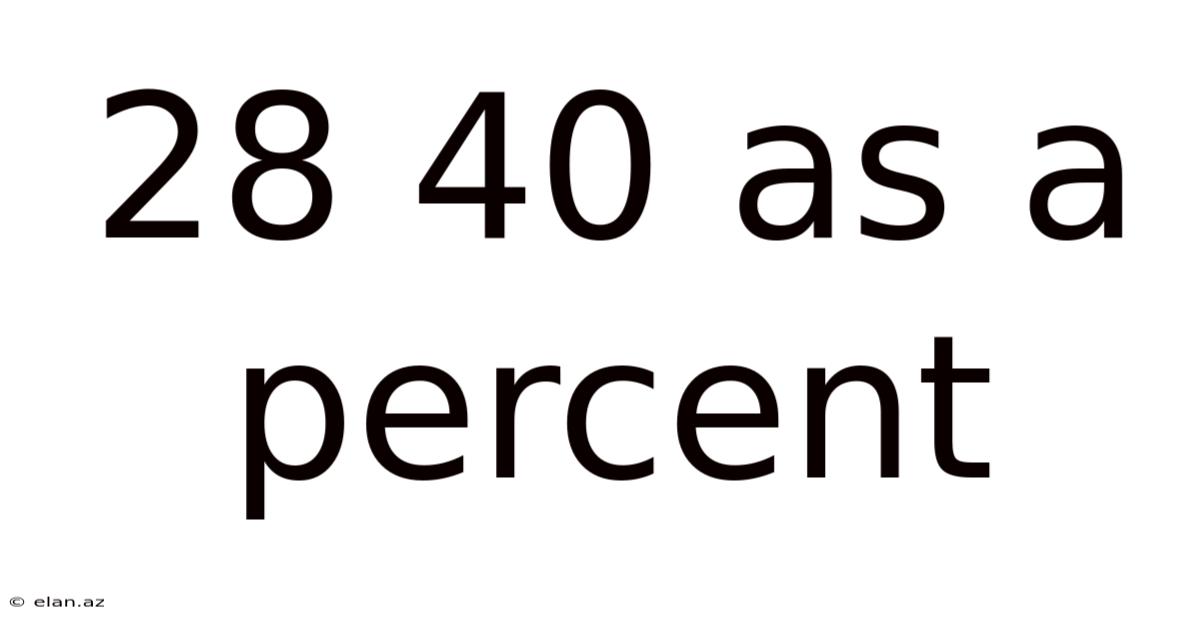28 40 As A Percent
elan
Sep 18, 2025 · 4 min read

Table of Contents
Decoding 28/40 as a Percentage: A Comprehensive Guide
Understanding percentages is a fundamental skill in various aspects of life, from calculating discounts and taxes to interpreting data and statistics. This article will comprehensively explore how to convert the fraction 28/40 into a percentage, delving into the underlying mathematical principles and offering practical applications. We'll cover the conversion process step-by-step, explain the significance of the result, and address frequently asked questions to ensure a thorough understanding. This guide is suitable for students, professionals, or anyone seeking to improve their numeracy skills.
Understanding Fractions and Percentages
Before diving into the conversion, let's briefly review the concepts of fractions and percentages. A fraction represents a part of a whole. It's expressed as a ratio of two numbers, the numerator (top number) and the denominator (bottom number). In our case, 28/40 means 28 parts out of a total of 40 parts.
A percentage, denoted by the symbol %, represents a fraction out of 100. It indicates how many parts out of 100 constitute a given portion. For example, 50% means 50 out of 100, or one-half. Percentages provide a standardized way to compare and interpret proportions.
Converting 28/40 to a Percentage: A Step-by-Step Guide
Converting a fraction to a percentage involves two primary steps:
Step 1: Convert the fraction to a decimal.
To do this, we divide the numerator (28) by the denominator (40):
28 ÷ 40 = 0.7
Step 2: Convert the decimal to a percentage.
To convert a decimal to a percentage, we multiply the decimal by 100 and add the "%" symbol.
0.7 × 100 = 70%
Therefore, 28/40 is equivalent to 70%.
Simplifying the Fraction for Easier Calculation
Before performing the division, it's often beneficial to simplify the fraction if possible. This simplifies the calculation and can make the process less prone to errors. We can simplify 28/40 by finding the greatest common divisor (GCD) of 28 and 40. The GCD of 28 and 40 is 4. Dividing both the numerator and the denominator by 4, we get:
28 ÷ 4 = 7 40 ÷ 4 = 10
This simplifies the fraction to 7/10. Now, converting 7/10 to a decimal is simpler:
7 ÷ 10 = 0.7
Converting 0.7 to a percentage remains the same:
0.7 × 100 = 70%
Simplifying the fraction beforehand makes the calculation more manageable, especially when dealing with larger numbers.
The Significance of 70%
The result, 70%, signifies that 28 represents 70% of 40. This percentage can be interpreted in various contexts. For instance, if a student answered 28 out of 40 questions correctly on a test, their score would be 70%. Similarly, if a business achieved 28 units of a sales target of 40 units, they would have achieved 70% of their goal.
Practical Applications of Percentage Calculations
Understanding percentage calculations is vital in numerous real-world situations:
- Academic Performance: Calculating grades, assessing test scores, and tracking progress.
- Financial Management: Calculating interest rates, discounts, taxes, and profit margins.
- Data Analysis: Interpreting statistical data, representing proportions, and visualizing trends.
- Business and Economics: Analyzing market shares, evaluating sales performance, and forecasting future trends.
- Everyday Life: Calculating tips, determining sale prices, and understanding proportions in recipes.
Understanding Percentage Increase and Decrease
The concept of percentage can also be used to calculate increases and decreases. Let's say the initial value was 40 and the final value is 28. To find the percentage decrease:
- Calculate the difference: 40 - 28 = 12
- Divide the difference by the initial value: 12 ÷ 40 = 0.3
- Multiply by 100 to get the percentage: 0.3 × 100 = 30%
Therefore, there is a 30% decrease from 40 to 28.
Beyond the Basics: Advanced Percentage Calculations
While converting 28/40 to a percentage is a straightforward process, more complex scenarios might involve finding a percentage of a number, calculating percentages based on multiple variables, or solving for unknown values in percentage equations.
Frequently Asked Questions (FAQ)
Q1: What if the fraction is an improper fraction (numerator > denominator)?
A: The process remains the same. Convert the improper fraction to a decimal by dividing the numerator by the denominator. Then, multiply the decimal by 100 to get the percentage. The resulting percentage will be greater than 100%.
Q2: Can I use a calculator for these calculations?
A: Yes, calculators can significantly simplify the process, especially for more complex fractions or decimals. Most calculators have a percentage function (%) that directly performs the conversion.
Q3: How can I improve my understanding of percentages?
A: Practice is key! Try converting various fractions to percentages, solve percentage-related word problems, and use online resources or educational materials to reinforce your understanding.
Conclusion
Converting 28/40 to a percentage is a fundamental mathematical skill with wide-ranging applications. By understanding the steps involved—dividing the numerator by the denominator and then multiplying by 100—you can confidently tackle various percentage-related problems. This ability is invaluable in academic settings, professional contexts, and everyday life, empowering you to interpret data, make informed decisions, and navigate the numerical world with greater ease and confidence. Remember to simplify fractions whenever possible to streamline the calculation process. With consistent practice, mastering percentages becomes intuitive and straightforward.
Latest Posts
Latest Posts
-
Snail And The Whale Pdf
Sep 18, 2025
-
List Of Ms Word Fonts
Sep 18, 2025
-
Sports That Start With H
Sep 18, 2025
-
The Eyes Of The Skin
Sep 18, 2025
-
Meaning Of Miscellaneous In Hindi
Sep 18, 2025
Related Post
Thank you for visiting our website which covers about 28 40 As A Percent . We hope the information provided has been useful to you. Feel free to contact us if you have any questions or need further assistance. See you next time and don't miss to bookmark.